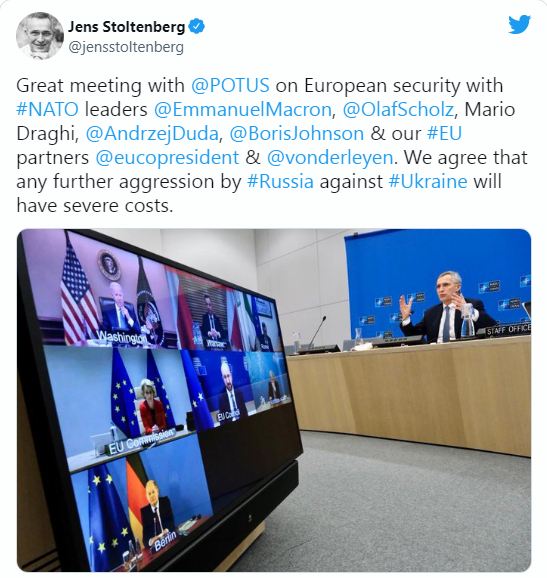[ad_1]
In recent days, efforts by NATO and its member states to counter a possible Russian invasion of Ukraine have accelerated and intensified.
From threats to impose very severe economic sanctions on Russia has now shifted to something more serious, the engagement of military troops. Although the diplomatic route remains open, the situation in Ukraine is becoming increasingly tense and even more difficult to resolve.
Russian President Vladimir Putin does not seem ready at the moment to withdraw the 100,000 troops gathered on the border with Ukraine, and at the same time NATO has ruled out the possibility of limiting the presence of its troops in Eastern Europe, considering the Russian request as unacceptable.
One of the most important signs of this military engagement came from the announcement by the US government that it had put on standby 8500 soldiers, who would soon be stationed in Eastern Europe to counter Russian aggression.
The decision was described by the New York Times as a “major change” for the Biden administration, which has so far taken a very cautious stance on the Ukrainian crisis in order to avoid provocations by the Russian government.
“Standby” means that in case of need 8500 soldiers can be transferred and activated very quickly. Some of these soldiers may be sent to NATO countries in Eastern Europe, such as Poland and Romania, where military units with specific functions and capabilities are required, the other side, most of the troops, may strengthen the NATO Response Force ( NRF), a NATO multinational force of 40,000 troops on standby in case of emergency.
This is an important detail, the United States wants to show that it does not want to act unilaterally against Russia, but that it will respond along with its allies.
The US president spoke on Monday in a video conference with several European leaders, announcing at the end of the meeting a “complete unanimity” with his allies. The meeting was attended by NATO Secretary General Jens Stoltenberg, European Commission President Ursula von der Leyen, European Council President Charles Michel, French President Emmanuel Macron, Italian Prime Minister Mario Draghi, German Chancellor Olaf Scholz, Polish President Andrzej Duda and the British Prime Minister, Boris Johnson.

Despite the “complete unanimity” proclaimed by Biden and other phrases reminiscent of the alliance unity expressed by the governments present at the meeting, the impression is that NATO is still struggling to find a real agreement on how to respond. Russia, both before and after the start of a possible invasion.
The divisions within the alliance, though partly physiological when it comes to such wide-ranging deals involving the use of force, had already surfaced since last week, especially after some controversial statements made by Biden.
The US president had stated that a “small attack” by Russia on Ukraine would lead the United States into “contradiction” with its European allies over the decision to respond to the Russians. Indeed, Russia has many options on how it can inflict damage on the Ukrainian government, ranging from a large-scale cyber attack (like the one the Russians may have carried out in mid-January) to an invasion of the country.
This is not the first time NATO has been allocated to Ukraine. On Monday, the supply of weapons to the Ukrainian army was also discussed; a topic that has always divided the alliance, with some countries, such as the United States and the United Kingdom, supporting the supply of weapons to the Ukrainian army, while others, such as Germany, are opposed.
Although NATO appears to have stalled, some countries have sent or announced the deployment of military troops to strengthen the alliance’s eastern border. Denmark, for example, said it had sent a warship to the Baltic Sea, announcing it had sent four F-16 jets to Lithuania. Spain is also sending a warship to join NATO forces in the Mediterranean and Black Sea, and is also considering sending fighter jets to Bulgaria. The Netherlands will deploy two F-35 aircraft in Bulgaria, while France said it would send troops to Romania in case of need.
Although the diplomatic path to resolving the crisis is still open, the presence of 100,000 Russian troops on the border with Ukraine and recent NATO moves have greatly complicated the situation.
According to Andrew Roth, a journalist and correspondent for The Guardian in Moscow, it has now become extremely difficult for the Russian government to withdraw its troops, especially in the wake of recent NATO announcements of troops being sent to the eastern border.
Such a move for Putin means “loss of dignity” both in front of his opponents, but also in front of his constituents.
Roth thinks Putin will not back down, and in all likelihood the presence of such a large number of military troops on the Ukrainian border, considered a unique and extraordinary move, has led many analysts to think that the Russian president is more real in seeking a war, with the aim of ousting NATO.
At the same time, Roth added, Western governments are showing that they are taking the possibility of a war very seriously, both by threatening harsh sanctions and by launching the evacuation of the families of foreign diplomats in Ukraine.
top channel
[ad_2]
Source link















